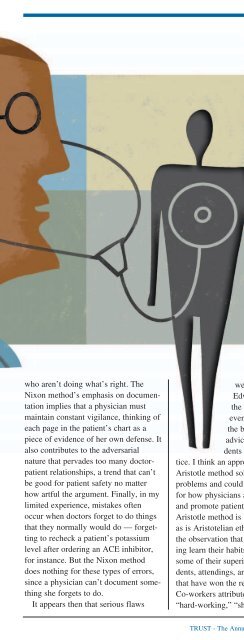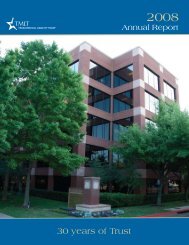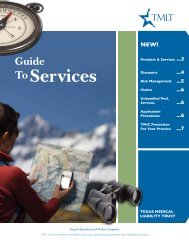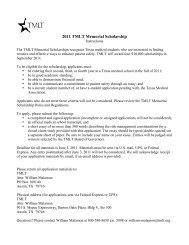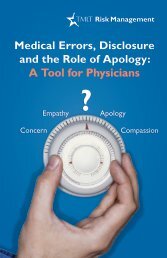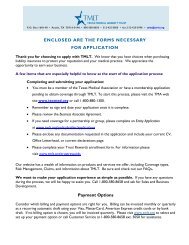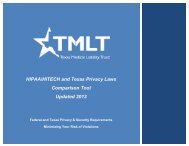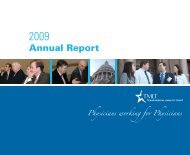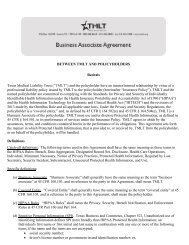Trust - TMLT
Trust - TMLT
Trust - TMLT
Create successful ePaper yourself
Turn your PDF publications into a flip-book with our unique Google optimized e-Paper software.
who aren’t doing what’s right. TheNixon method’s emphasis on documentationimplies that a physician mustmaintain constant vigilance, thinking ofeach page in the patient’s chart as apiece of evidence of her own defense. Italso contributes to the adversarialnature that pervades too many doctorpatientrelationships, a trend that can’tbe good for patient safety no matterhow artful the argument. Finally, in mylimited experience, mistakes oftenoccur when doctors forget to do thingsthat they normally would do — forgettingto recheck a patient’s potassiumlevel after ordering an ACE inhibitor,for instance. But the Nixon methoddoes nothing for these types of errors,since a physician can’t document somethingshe forgets to do.It appears then that serious flawsweaken both theEdwards method andthe Nixon method,even though they arethe basis for 70% of theadvice that medical studentshear about malpractice.I think an approach that I call theAristotle method solves some of theseproblems and could serve as a modelfor how physicians avoid malpracticeand promote patient safety. TheAristotle method is built around virtue,as is Aristotelian ethics. It stems fromthe observation that physicians-in-traininglearn their habits by emulatingsome of their superiors, especially residents,attendings, and other studentsthat have won the respect of their peers.Co-workers attribute virtues such as“hard-working,” “sharp,” “strong,” and“efficient,” to these role-models, but theAristotle method doesn’t mean thatphysicians can avoid malpractice bybeing stronger and sharper. It meansthat when taking care of patients, studentsshould imagine themselves verbalizingtheir analysis and decisionmakingto one of their professionalheroes. This mental exercise finds potholesin reasoning, and the act of forcingoneself to construct a coherent narrativehelps identify things that thephysician may have initially forgottento do.The Aristotle method is not the samething as asking inane self-questions like“What would Osler do in my position?”It advocates mental recapitulation, notsimple mimicry. We may find that wedisagree with our role models’ imaginedopinion, but we should then beable to offer good reasons for doing so.And if we honestly don’t know what heor she would think, then it might betime to consult the literature. This ideamay initially seem similar to theEdwards model, in which physicianspractice in constant fear of judgmentfor deviating from some standard, but Ithink it’s more positive since most of uswant to win recognition of the peoplewe look up to and we’re willing towork hard for it. And by thinking aboutwhat a specific person’s thoughts orcriticisms might be, it avoids the vaguenessinherent in “standard of care.” Itmay also look similar to the Nixonmodel, since documenting one’s reasoninggenerates the same kind of narrativeas imaginary verbalization. But I thinkit’s less cynical since it creates habitsfrom virtue rather than lawsuit avoidance,and it actively helps preventerrors of omission.As with any good practice, theAristotle method could be instituted ifthe professionals we respect tell us thatit’s a good idea. I think it’s a way thatavoiding lawsuits and promoting patientsafety can converge.TRUST - The Annual Report Magazine17


